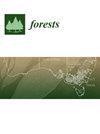欧洲和亚洲杜松品种的土壤要求、遗传多样性和种群历史
IF 2.4
2区 农林科学
Q1 FORESTRY
引用次数: 0
摘要
桧属乔木和灌木是北半球干旱和半干旱生态系统中的重要物种。然而,由于全球变暖,它们的种群出现了不利现象。我们的目的是调查欧洲、格鲁吉亚和吉尔吉斯斯坦的刺柏(Juniperus sabina L.)对土壤的要求、遗传多样性和种群历史。我们利用核微卫星对 16 个种群的遗传资源进行了评估,并根据叶绿体 DNA 单倍型描述了过去的人口活动。研究人员比较了 J. sabina 在欧洲分布的 36 个土壤样本中的七个化学参数。在所研究的地区,发现了三个不同的系统发育系,分别对应于不同的沙棘稷品种,即沙棘稷变种、巴尔干变种和亚洲变种。单模式错配分布和显著负的Tajima's D和Fu's Fs参数表明,sabina和balkanensis品种经历了种群扩张。微卫星变异适中,可能受到近亲繁殖、克隆繁殖和种群间有限基因流动的影响。贝叶斯聚类发现了五个基因群。与 sabina 品种相比,balkanensis 品种所在地区的土壤钾含量明显较高,这可能减轻了干旱对当地的不利影响。本文章由计算机程序翻译,如有差异,请以英文原文为准。
Soil Requirements, Genetic Diversity and Population History of the Juniperus sabina L. Varieties in Europe and Asia
Trees and shrubs belonging to the genus Juniperus L. are pivotal species in arid and semiarid ecosystems in the Northern Hemisphere. However, unfavourable phenomena are observed in their populations due to global warming. We aimed to investigate the soil requirements, genetic diversity and population history of Juniperus sabina L. from Europe, Georgia, and Kyrgyzstan. Genetic resources were evaluated in 16 populations using nuclear microsatellites, while past demographic events were described based on the chloroplast DNA haplotypes. Seven chemical parameters in 36 soil samples from the European range of J. sabina were compared. In the studied area, three distinct phylogenetic lineages corresponding to different varieties of J. sabina, namely var. sabina, var. balkanensis, and the Asian variety, were revealed. Unimodal mismatch distributions and significantly negative Tajima’s D and Fu’s Fs parameters indicated that the sabina and balkanensis varieties underwent a population expansion. Microsatellite variation was moderate, potentially influenced by inbreeding, clonal propagation, and limited gene flow between populations. Bayesian clustering revealed five genetic groups. Compared to var. sabina, the balkanensis variety occupies areas with significantly higher potassium content in the soil, which probably mitigates the adverse effects of drought in its localities.
求助全文
通过发布文献求助,成功后即可免费获取论文全文。
去求助
来源期刊

Forests
FORESTRY-
CiteScore
4.40
自引率
17.20%
发文量
1823
审稿时长
19.02 days
期刊介绍:
Forests (ISSN 1999-4907) is an international and cross-disciplinary scholarly journal of forestry and forest ecology. It publishes research papers, short communications and review papers. There is no restriction on the length of the papers. Our aim is to encourage scientists to publish their experimental and theoretical research in as much detail as possible. Full experimental and/or methodical details must be provided for research articles.
 求助内容:
求助内容: 应助结果提醒方式:
应助结果提醒方式:


